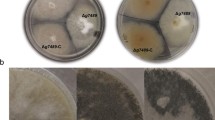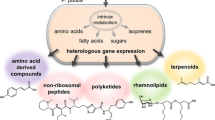Abstract
The regio-specific hydroxylation at the 4th N-methyl leucine of the immunosuppressive agent cyclosporin A (CsA) was previously proposed to be mediated by a unique cytochrome P450 hydroxylase (CYP), CYP-sb21 from the rare actinomycetes Sebekia benihana. Interestingly, a different rare actinomycetes species, Pseudonocardia autotrophica, was found to possess a different regio-selectivity, the preferential hydroxylation at the 9th N-methyl leucine of CsA. Through an in silico analysis of the whole genome of P. autotrophica, we describe here the classification of 31 total CYPs in P. autotrophica. Three putative CsA CYP genes, showing the highest sequence homologies with CYP-sb21, were successfully inactivated using PCR-targeted gene disruption. Only one knock-out mutant, ΔCYP-pa1, failed to convert CsA to its hydroxylated forms. The hydroxylation activity of CsA by CYP-pa1 was confirmed by CYP-pa1 gene complementation as well as heterologous expression in the CsA non-hydroxylating Streptomyces coelicolor. Moreover, the cyclosporine regio-selectivity of CYP-pa1 expressed in the ∆CYP-sb21 S. benihana mutant strain was also confirmed unchanged through cross complementation. These results show that preferential regio-specific hydroxylation at the 9th N-methyl leucine of CsA is carried out by a specific P450 hydroxylase gene in P. autotrophica, CYP-pa1, setting the stage for the biotechnological application of CsA regio-selective hydroxylation.





Similar content being viewed by others
References
Behal V (2000) Bioactive products from Streptomyces. Adv Appl Microbiol 47:113–156
Benson DA, Karsch-Mizrachi I, Lipman DJ, Ostell J, Wheeler DL (2008) GenBank. Nucleic Acids Res 36:D25–D30
Delort AM, Jeminet G, Sancelme M, Dauphin G (1988) Microbial conversion of nigericin in three successive steps, by Sebekia benihana. J Antibiot 41:916–924
Falquet L, Pagni M, Bucher P, Hulo N, Sigrist CJA, Hofmann K, Bairoch A (2002) The PROSITE database, its status in 2002. Nucleic Acids Res 30:235–238
Fouces R, Mellado E, Díez B, Barredo JL (1999) The tylosin biosynthetic cluster from Streptomyces fradiae: genetic organization of the left region. Microbiology 145:855–868
Gust B, Challis GL, Fowler K, Kieser T, Chater KF (2003) PCR-targeted Streptomyces gene replacement identifies a protein domain needed for biosynthesis of the sesquiterpene soil odor geosmin. Proc Natl Acad Sci USA 100:1541–1546
Ikeda H, Nonomiya T, Usami M, Ohta T, Omura S (1999) Organization of the biosynthetic gene cluster for the polyketide anthelmintic macrolide avermectin in Streptomyces avermitilis. Proc Natl Acad Sci USA 96:9509–9514
Ioannides C, Lewis DFV (2004) Cytochromes P450 in the bioactivation of chemicals. Curr Top Med Chem 4:1767–1788
Kanehisa M, Araki M, Goto S, Hattori M, Hirakawa M, Itoh M, Katayama T, Kawashima S, Okuda S, Tokimatsu T, Yamanishi Y (2008) KEGG for linking genomes to life and the environment. Nucleic Acids Res 36:D480–D484
Kieser T, Bibb MJ, Buttner MJ, Chater KF, Hopwood DA (2000) Practical Streptomyces genetics: a laboratory manual. The John Innes Foundation, Norwich
Lee MJ, Han K, Kim ES (2011) Targeted gene disruption and functional complementation of cytochrome p450 hydroxylase involved in cyclosporin a hydroxylation in Sebekia benihana. J Microbiol Biotechnol 21:14–19
Lee MJ, Kim HB, Yoon YJ, Han K, Kim ES (2013) Identification of a cyclosporine-specific P450 hydroxylase gene through targeted cytochrome P450 complement (CYPome) disruption in Sebekia benihana. Appl Environ Microbiol 79:2253–2262
LG household and health care (2008) Nonimmunosuppressive [γ-hydroxy-N-methyl-L-Leucine4]cyclosporin derivatives for protection from antineoplastic chemotherapy-induced hair loss. Korean Patent 1008652110000
LG household and health care (2007) Use of [γ-hydroxy-N-methyl-L-leucine9]cyclosporin A for hair growth. Korean Patent 1006816700000
Paradkar A, Trefzer A, Chakraburtty R, Stassi D (2003) Streptomyces genetics: a genomic perspective. Crit Rev Biotechnol 23:1–27
Park NS, Park HJ, Han K, Kim ES (2006) Heterologous expression of novel cytochrome P450 hydroxylase genes from Sebekia benihana. J Microbiol Biotechnol 16:295–298
Porter CT, Bartlett GJ, Thornton JM (2004) The Catalytic Site Atlas: a resource of catalytic sites and residues identified in enzymes using structural data. Nucleic Acids Res 32:D129–D133
Sohng JK, Oh TJ (2010) Streptomyces cytochrome P450 and electron transport system. Korean J Microbiol Biotechnol 38:227–234
Suzek BE, Huang H, McGarvey P, Mazumder R, Wu CH (2007) UniRef: comprehensive and non-redundant UniProt reference clusters. Bioinformatics 23:1282–1288
Takano E, White J, Thompson CJ, Bibb MJ (1995) Construction of thiostrepton-inducible, high-copy-number expression vectors for use in Streptomyces spp. Gene 166:133–137
Tatusov RL, Koonin EV, Lipman DJ (1997) A genomic perspective on protein families. Science 278:631–637
Vara J, Lewandowska-Skarbek M, Wang YG, Donadio S, Hutchinson CR (1989) Cloning of genes governing the deoxysugar portion of the erythromycin biosynthesis pathway in Saccharopolyspora erythraea (Streptomyces erythreus). J Bacteriol 171:5872–5881
Vaufrey F, Delort AM, Jeminet G, Dauphin G (1990) Bioconversion of monensin by a soil bacterium, Sebekia benihana. J Antibiot 43:1189–1191
Xue Y, Wilson D, Zhao L, Liu HW, Sherman DH (1998) Hydroxylation of macrolactones YC-17 and narbomycin is mediated by the pikC-encoded cytochrome P450 in Streptomyces venezuelae. Chem Biol 5:661–66717
Acknowledgments
The authors appreciate the financial and technical support provided by Inha University. This work was supported through the Global Frontier Program for Intelligent Synthetic Biology in Korea, and also in part through a grant from the Next-Generation BioGreen 21 Program, Rural Development Administration (RDA) in Korea.
Author information
Authors and Affiliations
Corresponding author
Electronic supplementary material
Below is the link to the electronic supplementary material.
Rights and permissions
About this article
Cite this article
Ban, JG., Woo, MW., Lee, BR. et al. A novel regio-specific cyclosporin hydroxylase gene revealed through the genome mining of Pseudonocardia autotrophica . J Ind Microbiol Biotechnol 41, 879–886 (2014). https://doi.org/10.1007/s10295-014-1432-5
Received:
Accepted:
Published:
Issue Date:
DOI: https://doi.org/10.1007/s10295-014-1432-5




